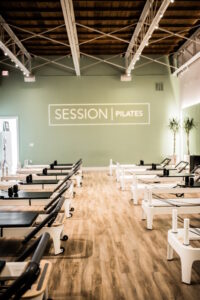
Pilates is a versatile exercise method that can be practiced using various types of equipment, each designed to enhance the effectiveness and diversity of the workouts. Pilates equipment, such as reformers, Cadillacs, and more, offer unique features and benefits that cater to different needs and levels of practitioners. In this article, we will explore the different types of Pilates equipment, including the reformer and Cadillac, and discuss how they are used to enhance the Pilates practice.
What is the name of the Pilates equipment reformer?
The Pilates reformer is perhaps the most well-known and widely used piece of Pilates equipment. It consists of a sliding carriage, equipped with springs and straps, which allows for a wide range of exercises to be performed. The reformer provides resistance and assistance, helping individuals develop strength, stability, and flexibility. It can be used in a variety of positions, including lying down, sitting, or standing, offering countless possibilities for challenging and engaging the entire body.
What is a Cadillac Reformer Pilates?
A Cadillac, also known as a Trapeze Table, is another popular piece of Pilates equipment that offers a versatile and comprehensive workout experience. The Cadillac features a horizontal platform with an overhead frame that incorporates a variety of bars, straps, and springs. This setup allows for a wide range of exercises to be performed in various positions, including lying down, sitting, or hanging. The Cadillac offers a combination of strength, flexibility, and balance exercises, making it suitable for both rehabilitation and advanced Pilates training. It provides support, resistance, and assistance as needed, making it accessible to individuals with varying levels of fitness and physical abilities.
What equipment is used during Pilates?
In addition to the reformer and Cadillac, Pilates utilizes various other pieces of equipment to enhance the practice. Some common examples include the Pilates chair, also known as the Wunda Chair, which offers seated and standing exercises for challenging the core and lower body; the Pilates barrel, which helps improve spinal flexibility and mobility; and the Pilates spine corrector, designed to support the back and shoulders while performing exercises to strengthen the core and promote better posture. Each piece of equipment adds diversity and challenge to the Pilates practice, allowing individuals to target different muscle groups and movement patterns.
How do you use a Pilates Cadillac?
Using a Pilates Cadillac involves a combination of exercises performed on the various components of the equipment. The Cadillac features bars, springs, and straps that can be adjusted to accommodate different exercises and individual needs. It offers a wide range of exercises, including stretching, strengthening, and mobilizing movements.
To use a Pilates Cadillac, one typically starts with setting up the equipment by adjusting the springs, straps, and bars according to the desired resistance and exercise requirements. From there, exercises can be performed in different positions, such as lying down, sitting, or hanging from the bars. The Cadillac allows for exercises targeting various areas of the body, including the core, upper body, and lower body. It provides support, stability, and resistance as needed, allowing individuals to progress and challenge themselves safely.
Pilates equipment, including the reformer, Cadillac, and other pieces, adds versatility, resistance, and assistance to the Pilates practice. The reformer offers a sliding carriage for a wide range of exercises, while the Cadillac provides a comprehensive workout using bars, springs, and straps. Other equipment such as the chair, barrel, and spine corrector further enhance the Pilates experience. By utilizing these various pieces of equipment, practitioners can engage different muscle groups, improve strength, flexibility, and balance, and customize their workouts to their specific needs and goals.